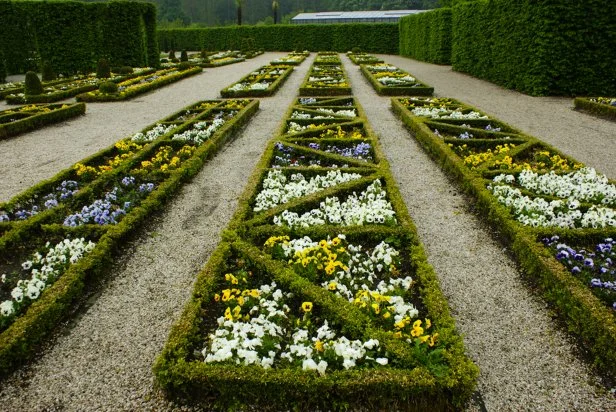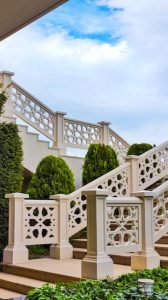Imagine stepping into a world where nature’s beauty is crafted with precision and elegance. That’s exactly what a formal garden design offers you.
It’s not just about planting flowers; it’s about creating a masterpiece that appeals to your senses and brings harmony to your outdoor space. You might be wondering, what sets a formal garden apart from other types of gardens? It’s the symmetry, the balance, and the carefully planned layout that draws your attention and keeps you fascinated.
If you’re dreaming of a garden that not only looks stunning but also makes you feel relaxed and inspired, then understanding the nuances of formal garden design is essential. This article will guide you through the core elements and principles that define this timeless style, allowing you to envision how it can transform your own garden into a captivating sanctuary. Are you ready to unlock the secrets of formal garden design and discover how it can elevate your outdoor space? Let’s dive in!

Credit: cgla.co.uk
Formal Garden Design Basics
Formal garden designs are a testament to the harmonious blend of nature and human creativity. They are defined by their symmetry, geometry, and meticulous planning. The basics of formal garden design offer a structured aesthetic that can transform any space into a serene oasis.
Defining Formal Gardens
Formal gardens are characterized by their symmetrical patterns and precise layouts. They often feature geometric shapes and lines that create a sense of order and balance. Think of clipped hedges, neatly arranged flower beds, and paved pathways that guide your stroll.
These gardens are not just about aesthetics; they provide a calming environment where each element has its place. The attention to detail in plant selection and placement is crucial. Ever wondered why these gardens feel so timeless? It’s because they follow principles that have been refined over centuries.
Historical Origins
The roots of formal gardens can be traced back to ancient civilizations. The Egyptians, Greeks, and Romans were some of the earliest adopters of structured garden designs. These cultures used gardens as a symbol of power and control over nature.
During the Renaissance, formal gardens reached new heights of sophistication in Europe. The gardens of Versailles are a prime example, showcasing how art and nature can coexist beautifully. Have you ever walked through a garden and felt like you were in a living painting? That’s the impact of these historical influences.
As you consider creating your own formal garden, reflect on these rich historical traditions. They offer endless inspiration and guidance, allowing you to craft a space that is both beautiful and meaningful. What story will your garden tell?
Key Elements Of Formal Gardens
Formal garden design features symmetry and order, with geometric shapes and neatly trimmed hedges. Statues and fountains often add elegance and charm.
Formal gardens have a unique charm that invites admiration and contemplation. Their beauty lies in a structured harmony created by carefully considered elements. If you’ve ever wandered through one, you might have felt the calming effect of its orderly design. This section delves into the key elements that define these captivating spaces.Symmetry And Balance
Symmetry is the cornerstone of formal garden design. It’s about creating a mirror image on either side of a central path or feature. Imagine a grand entrance flanked by identical rows of hedges or flower beds. This predictable balance brings a sense of peace and order. When you design your garden with symmetry in mind, you create a space that feels cohesive and intentional.Geometric Shapes
Formal gardens often rely on geometric shapes to guide their design. Squares, circles, and triangles form the backbone of paths, flower beds, and lawns. These shapes help in organizing the garden into distinct sections that are easy to navigate. Think about how a circular fountain can become the focal point in a square courtyard. Using geometry in your garden can transform it into a work of art.Structured Planting
The choice and arrangement of plants are crucial in a formal garden. Plants are usually chosen for their ability to be trimmed and shaped, such as boxwoods and yews. These structured plantings provide a neat appearance and can be used to create living walls or intricate patterns. Would you enjoy a garden where every plant has its place, creating a sense of order and predictability? Structured planting allows for that kind of precision and beauty. By focusing on these key elements, you can create a formal garden that not only looks stunning but also provides a serene space for relaxation. What elements will you incorporate into your own garden?Types Of Formal Gardens
Formal garden design focuses on symmetry, order, and balance. Common types include French, Italian, and English gardens. Each style features well-defined shapes, manicured hedges, and structured layouts.
Formal gardens are a celebration of symmetry and order, offering a structured beauty that captivates the senses. These gardens are not just about plants; they’re about creating a work of art that reflects cultural history and aesthetic principles. Let’s explore some classic types of formal gardens that have stood the test of time.French Formal Gardens
French formal gardens, also known as Jardins à la française, are the epitome of elegance and grandeur. They often feature geometric patterns, long avenues, and reflective water bodies. Think of the magnificent gardens at Versailles, where precision and symmetry reign supreme. These gardens are designed to impress, with a focus on visual harmony and control over nature. Shrubs are meticulously trimmed to create intricate designs. If you love the idea of walking through a living tapestry, a French formal garden might be the right choice for you.Italian Renaissance Gardens
Italian Renaissance gardens are a blend of art and nature, often found surrounding grand villas. They are characterized by their use of terraces, grottos, and fountains. Imagine strolling through a garden where every view is framed like a painting. These gardens emphasize harmony with the surrounding landscape, often incorporating sculptures and classical architecture. The terraces allow for different levels of interaction, providing stunning views and intimate spaces. Wouldn’t it be wonderful to sip a morning coffee while enjoying such timeless beauty?English Formal Gardens
English formal gardens are known for their combination of structured layouts with vibrant, colorful plantings. Unlike the strict symmetry of French gardens, English gardens often feature a more relaxed geometry. However, they still maintain a strong sense of order and design. These gardens can include elements like topiary, hedges, and flower beds in bold patterns. The balance between structure and natural beauty offers a serene and inviting atmosphere. Can you imagine a better place to unwind after a busy day than your own slice of English garden paradise? Each type of formal garden brings its own unique charm and history. As you consider which style resonates with you, think about how you want your outdoor space to feel. Would you prefer the regal formality of a French garden, the artistic allure of an Italian one, or the harmonious blend of an English garden? The choice is yours to make.
Credit: www.hgtv.com
Design Techniques
Formal garden design emphasizes symmetry, order, and geometric shapes. It features neatly trimmed hedges, structured paths, and balanced layouts. This style exudes elegance and timeless beauty.
Formal garden designs offer a structured and harmonious environment. They use symmetry and geometry to create elegance. Design techniques are crucial in achieving this aesthetic. They guide the layout and enhance the garden’s visual appeal. Let’s explore some key techniques.Pathways And Borders
Pathways lead visitors through the garden. They can be straight or curved. Gravel, stone, or brick are popular materials. Borders define spaces and add texture. They often include hedges or flower beds. These elements create order and direction.Focal Points And Features
Focal points draw attention in the garden. Statues, sundials, or large plants can serve this role. Features add interest and depth. Consider sculptures or large urns. They provide a central point for the design.Use Of Water Elements
Water elements add tranquility and movement. Fountains or ponds are common choices. They reflect light and create soothing sounds. Proper placement enhances the garden’s harmony. Water features can be focal points or subtle accents.Benefits Of Formal Garden Design
Formal garden design creates symmetry and order, offering a peaceful and elegant outdoor space. This design enhances curb appeal and provides a structured environment for relaxation and enjoyment.
Formal garden design is more than just an arrangement of plants and pathways; it’s a testament to the art of landscaping that offers numerous benefits. Whether you’re a seasoned gardener or someone considering a garden makeover, understanding these benefits can help you make informed decisions about your outdoor space. Let’s dive into the advantages of embracing a formal garden design.Aesthetic Appeal
Formal gardens are renowned for their striking symmetry and orderly structure. This design creates a visual harmony that appeals to the eye, offering a sense of calm and balance. Imagine stepping into a garden where every element feels thoughtfully placed—it’s like walking into a living masterpiece. The clean lines and geometric shapes provide an elegant backdrop that can elevate any property.Enhanced Property Value
A well-maintained formal garden can significantly boost your property’s market appeal. Potential buyers often perceive these gardens as a sign of a well-cared-for home. It’s an investment that can pay off if you ever decide to sell. In fact, many real estate experts agree that a beautifully designed garden can increase property value by up to 20%. Wouldn’t you want your home to stand out in a competitive market?Low Maintenance
Despite their intricate appearance, formal gardens can be surprisingly low maintenance. The structured design often incorporates hardy plants that require less attention. With strategic planning, you can create a garden that stays beautiful with minimal effort. For instance, choosing perennial plants can reduce the need for frequent replanting. Imagine having more time to enjoy your garden rather than constantly working in it. In summary, a formal garden design offers aesthetic charm, adds value to your property, and can be relatively easy to maintain. Are you ready to transform your outdoor space into a beautiful, stress-free sanctuary?
Credit: www.hgtv.com
Creating Your Own Formal Garden
Formal garden design features symmetry and order, using geometric shapes and structured layouts. These gardens often include hedges, pathways, and focal points like fountains or statues. They create a tranquil, elegant outdoor space.
Creating your own formal garden can be a rewarding experience that transforms your outdoor space into a sanctuary of beauty and order. With its symmetrical designs and well-defined shapes, a formal garden is both timeless and elegant. Imagine walking through your garden, where every element is in harmony, creating a sense of peace and structure. Ready to get started? Here’s how you can create a formal garden that reflects your personal style and meets your needs.Planning And Layout
Start by sketching a detailed plan of your garden. Decide on geometric shapes such as rectangles, squares, or circles, which are fundamental to formal garden design. Think about pathways, which should be straight and defined, leading the eye to focal points like a statue or a fountain. Use a measuring tape to mark out these areas in your space, ensuring precision in your layout. Visualize how you want to move through the garden and how each section will connect.Choosing Plants And Materials
Select plants that enhance the symmetry and order of your design. Consider evergreens like boxwood, which can be trimmed into neat hedges and maintain their shape year-round. Flowering plants like roses or lavender add color and fragrance while staying true to the formal theme. Choose materials such as stone or brick for pathways and borders to give a classic and enduring look. Don’t forget to consider the climate and sunlight in your area to ensure your plants thrive.Maintenance Tips
Regular maintenance is key to keeping a formal garden looking pristine. Schedule weekly tasks like trimming hedges and mowing lawns to maintain clean lines. Keep an eye on symmetry, ensuring plants grow evenly and replace any that disrupt the balance. Incorporate seasonal tasks such as mulching and fertilizing to promote healthy growth. Consider setting reminders or creating a calendar to stay organized with your garden upkeep. What strategies will you adopt to maintain your garden’s elegance throughout the year?Inspirational Examples
Formal garden design features symmetry and order with geometric shapes. Elegant paths and manicured hedges create structured beauty. Strategic plant placement enhances visual harmony.
Imagine walking through a garden where every plant is placed with precision, and every path leads you to a stunning view. Formal garden design is all about structure, symmetry, and meticulous planning. These gardens can offer a sense of order and tranquility, providing inspiration for your own outdoor space. Below, explore some of the most captivating examples of formal garden design that have left their mark on history and continue to inspire today.Famous Formal Gardens
Some of the world’s most iconic gardens exemplify the beauty of formal design. The Gardens of Versailles in France showcase grand avenues, perfectly trimmed hedges, and majestic water features. It’s a place where art and nature elegantly converge. In England, the gardens of Blenheim Palace highlight symmetry and grandeur. Designed by famous landscape architect Lancelot ‘Capability’ Brown, these gardens balance structured elements with sweeping vistas. It’s a testament to how thoughtful design can enhance natural beauty.Contemporary Interpretations
Modern designers are reimagining formal gardens with a fresh twist. Today’s formal gardens might blend traditional elements with sustainable practices, like using drought-resistant plants that require less water. Consider the use of geometric patterns with native plants in your garden. This not only respects local ecosystems but also brings a unique flair to the classic formal style. Have you thought about integrating art into your garden? Contemporary formal gardens often feature sculptures or installations, adding a personal touch and creating focal points. What inspiration will you draw from these examples to create your own formal garden masterpiece?Frequently Asked Questions
What Defines A Formal Garden Design?
A formal garden design is characterized by geometric shapes, symmetry, and order. It often includes neatly trimmed hedges, well-defined paths, and carefully planned plantings. This design aims for a controlled, harmonious look, often featuring focal points like fountains or sculptures.
How Do You Plan A Formal Garden?
Planning a formal garden involves choosing a symmetrical layout and selecting plants that can be shaped. Begin with a central focal point, like a fountain. Use pathways to create balance and structure. Select plants that are easy to maintain and can be neatly trimmed.
What Plants Are Ideal For Formal Gardens?
Ideal plants for formal gardens include boxwood, yew, and privet for hedges. Roses, lavender, and topiary trees are great for adding elegance. These plants can be easily shaped and maintained, providing structure and beauty to the garden.
Why Are Symmetry And Order Important?
Symmetry and order create a sense of balance and tranquility in formal gardens. These elements guide the eye and create a pleasing aesthetic. They also help organize the space, making it easier to maintain and enjoy.
Conclusion
Formal garden design brings elegance and order to outdoor spaces. It uses symmetry and geometry to create a balanced look. This style is perfect for those who love structure and neatness. You can use hedges, pathways, and water features to enhance beauty.
Formal gardens can fit in small or large spaces. They offer a timeless appeal that many find peaceful. Planning and maintenance are key to success. Start small, and gradually expand. With patience, you can enjoy a beautiful, formal garden. Let your creativity guide your design choices.
Your garden can become a serene retreat.








